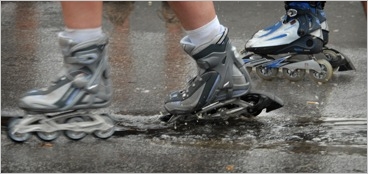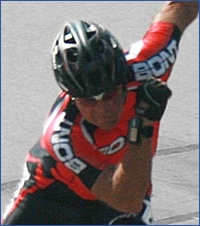 | ||
| ||||||||
By Roger Olson
Puddle Push - 2006 Northshore Inline Marathon When it comes to skating in the rain, I learned from a great teacher: experience. During my two years living in Hawaii, I rolled more than a thousand miles in the rain. I lived in the Manoa Valley of Honolulu, where it rains most mornings, and I commuted through this rain to my job in Pearl City — on skates. I estimate that on average I skated two to four miles a day in the rain, about 300 days a year. Multiply that by 2.5 (the number of years I lived in Hawaii) and you get a grand total of 1500 to 3000 miles of skating in the rain. Ever since I returned from Hawaii, I have had what seems like an advantage over other skaters when competing in wet conditions. Of course, there's no substitute for experience. But here are some hints that will help keep you rolling even when the wet stuff is flowing. Rain Rules 1) Use a short stride. Extend your skates no further than 6 inches past the line of your shoulders when you push. This will keep your body centered, which will help you maintain your balance when your wheels slip. 2) Use a quick cadence. With a shorter stroke, you'll have less power. To compensate, increase the tempo of your pushes. 3) Keep your weight over your heels. This is always a good idea, but never more so then in the rain when pavement tends to be littered with debris, some of which is covered by water. 4) Push straight out to the side. Push toward 3 o'clock with the right skate and 9 o'clock with the left. End your push with all wheels on the ground. Then lift your wheels off the pavement simultaneously (without toe-pushing or flicking). This keeps your push smooth and powerful and helps keep you balanced. 5) Bend your knees. A deep knee bend lowers your center of gravity, placing you in a stable position and allowing you to adjust your balance easily. Bent knees also act as natural shock absorbers. Shoot for 90 degrees of knee bend. (This is ideal though hard to achieve.) Remember to bend from the knees, not the waist. 6) Use soft wheels. Softer wheels (82A or less) grip better and slip less. Rain Hazards Road paint: Lane markers and road markings of any kind are extremely slippery when wet. Avoid them! Oily spots: Watch out for the center of traffic lanes, especially at intersections. They are often coated with a thin layer of engine oil, which becomes extremely slippery when wet. Large puddles: When your wheels hit a patch of standing water, they slow down (due to drag). This can throw your body forward, causing you to fall. To prevent this, keep your weight over the back of your skates. (Sit back on your heels.) Then you're body will slow down along with your skates and you will roll right through the puddle. Smooth concrete: In wet weather, this otherwise optimal skating surface can become as slick as ice. Bearings
Skating in the rain is bound to get water in your bearings, and that will make them rust. So after skating in the rain, do one of the following:
Boots Rain — especially heavy rain — can also damage your boots by loosening the glues and resins that help keep the pieces together. If you're worried about this, wear rain covers, like the ones made by Ezeefit Sports. They keep most of the water out. Drizzle vs. Typhoon I've found that light rain makes for more slippery conditions than hard rain. For some reason, wheels seem to grip better when it's raining hard. On the other hand, you don't have to worry about large puddles with light rain. Skate On Skaters often use the rain as an excuse to stay home. But with a few adjustments, you can keep rolling in just about any weather. Sure, rain makes skating a little more challenging. But isn't challenge part of what we love about our sport? • Poll: Do you skate in the rain?
Related reading: • Skate Tip of the Week Archive
...
Copyright © 2007 by Robert Burnson | ||||||||



